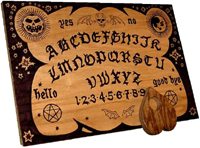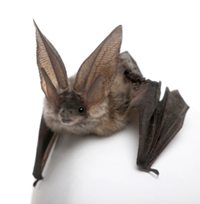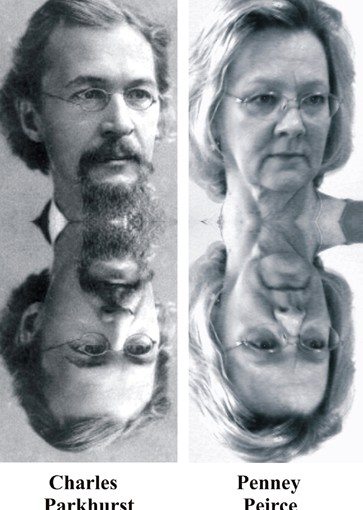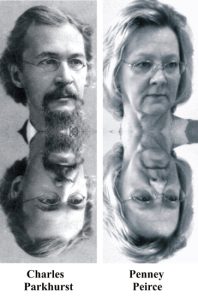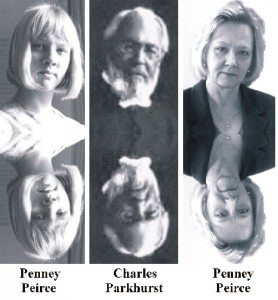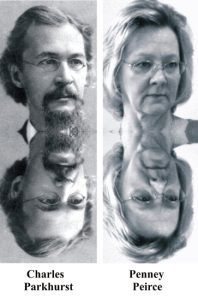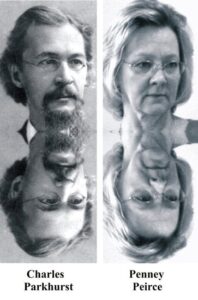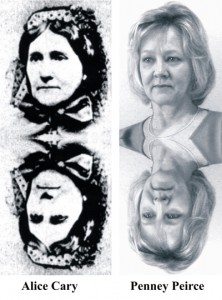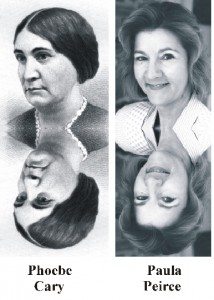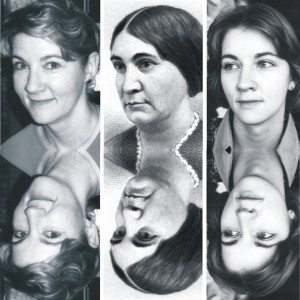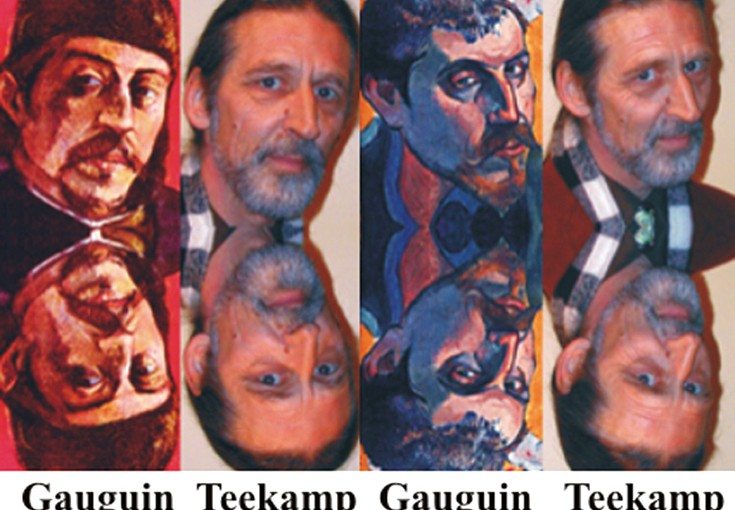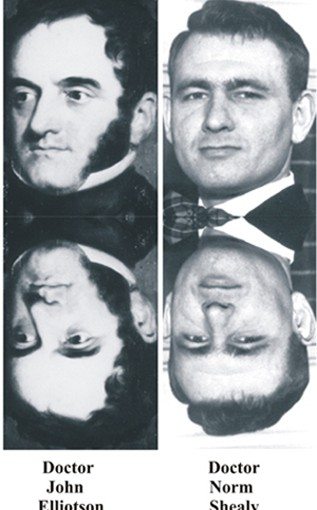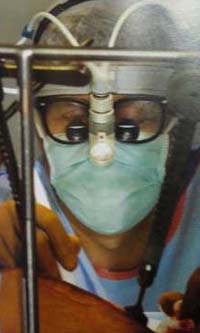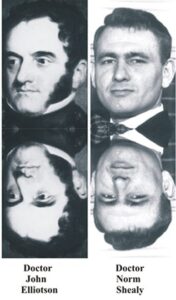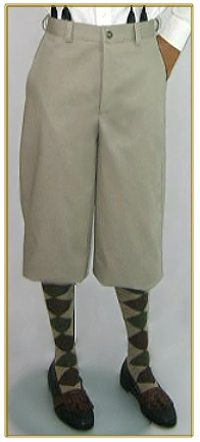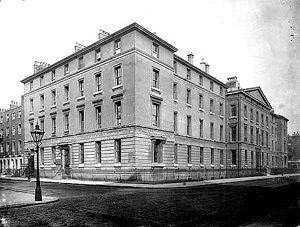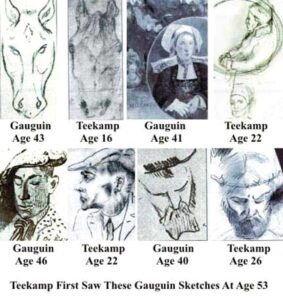 How Case Derived: Past Life Memories in Childhood, Spirit Being and Intuitive Guidance
How Case Derived: Past Life Memories in Childhood, Spirit Being and Intuitive Guidance
Researchers: Peter Teekamp and Michelle Moshay
Website: https://www.facebook.com/PeterTeekamp.Artist
Article by: Walter Semkiw, MD, from Born Again and Return of the Revolutionaries
Preface: Artistic Development Replicated in a Reincarnation Case
The image comparison on the right demonstrates how Peter Teekamp unconsciously replicated the artistic development of Paul Gauguin. This image, as well as all the images on this page, can be enlarged by placing your cursor over the image. Peter did these sketches as a young man, decades before he ever saw the corresponding Gauguin sketches in his contemporary lifetime, showing how artistic development has been unconsciously replicated.
Peter didn’t fully accept being the reincarnation of Gauguin until 2005, when he attended a conference, which was kindly hosted by Norm Shealy, MD, PhD at his farm in Missouri. There, Peter met others, such as Norm and Wayne Peterson, who also knew of past lives. Peter’s story made more sense in the context of other reincarnation cases.
Peter was 55 years old at the time. I supported that Peter is the reincarnation of Gauguin, but noted that Peter’s paintings up to that point did not look like those of Gauguin. Rather, Peter’s work was more realistic and even surrealistic. An example of Peter’s contemporary work is the portrayal of the Moon, provided below. I asked Peter if he could paint like Paul, as this might help others consider that he might be is the reincarnation of Paul.
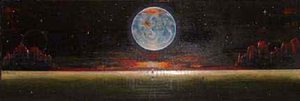 Subsequently, Peter effortlessly created a flood of paintings inspired by Paul Gauguin. On this web page, Gauguin’s paintings are compared with those done by Peter. A symbolic or synchronistic event is seen in Peter’s creation of these paintings at the age of 55, as Paul Gauguin died at the age of 55. It is as if Paul was resurrected in Peter at that time.
Subsequently, Peter effortlessly created a flood of paintings inspired by Paul Gauguin. On this web page, Gauguin’s paintings are compared with those done by Peter. A symbolic or synchronistic event is seen in Peter’s creation of these paintings at the age of 55, as Paul Gauguin died at the age of 55. It is as if Paul was resurrected in Peter at that time.
As a Boy, Peter Hears a Past Life Voice in his Mind: “Gauguin”
Peter Teekamp’s story begins in his childhood years, when the words “Go-Gone, Go-Gone,” kept popping into his mind. As a ten-year old boy, Peter would use it as a cheer when playing. He would shout: “Go-Gone, Go-Gone!”
This is reminiscent to the case of Francesco Foscari | Wayne Peterson, as Wayne as a child insisted that his name was really “Francesco Forscari,” not realizing until several decades later that his name was indeed Francesco Foscari in a past lifetime.
For Peter, it also took several decades before he associated the words “Go-Gone” with the artist Paul Gauguin and even longer for him to consider that he might be the reincarnation of Gauguin. Before we continue with Peter’s journey, let us review the life of Gauguin.
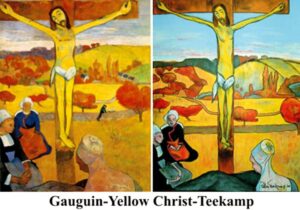
The Life and Death of Paul Gauguin
Paul was born in Paris on June 7, 1848. His father was a French journalist and his mother was from Peru.
In 1849, when Paul was only a year old, his father died during a sea passage to South America. His mother took Paul to Peru, where he spent his early childhood years. In his adolescence, he returned to France where he attended Catholic boarding schools. Paul’s Catholic upbringing would significantly influence his art. His mother died in 1867, when he was 19 years of age.
Paul Gauguin Travels the World then Settles Down in Paris
Paul then became a sailor, traveling around the world with the French Merchant Marines, then serving with the French Navy. In 1872, when he was 24, Paul entered the business world as a stockbroker. During this period, he began painting in his spare time. He would continue to work in business for over ten years, before devoting his life to painting full-time.
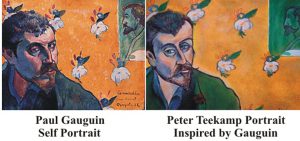
In 1873, at the age of 25, Paul married Mette Gad. The couple would eventually have five children. During this time in his young adulthood, Paul was befriended by the artists Pissarro and Cezanne. In 1880, when Paul was 28, one of his paintings was accepted for the Salon d’Automne, a prestigious art exhibition in Paris.
In 1884, Paul moved his family to Copenhagen, in Denmark, his wife’s country of origin. A year later, in 1885 and at the age of 37, Paul separated from Mette and returned to France to become an artist on a full-time basis. Upon his return, one his of first paintings was of a scene from the town of St. Cloud, just outside of Paris, entitled, “Paysage a Saint-Cloud.” St. Cloud, we shall see, will also have significance in the life of Peter Teekamp.
Paul Gauguin and Van Gogh in Arles, France
In 1887, Paul briefly worked for the Panama Canal project as a canal digger and he then traveled to Martinique, a Caribbean island. Returning to France, he became friends with Vincent Van Gogh, whom he painted with at Arles in the south of France. Van Gogh and Paul shared a house together and it was in this setting that on December 23, 1888, Van Gogh cut off his ear, which he then presented to a prostitute.
Paul reported that Van Gogh had threatened him with a razor the day prior to the ear incident. The day after Van Gogh cut off his ear, Gauguin left Arles.
During his period at Arles, from February to December 1888, Paul developed the style that he is known for, using flat, pure colors with black outlines. His art often involved Christian religious themes. Though the art world would come to revere Paul in the future, at this time, he was unrecognized and poor.
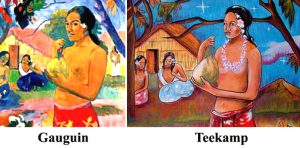 Paul Gauguin in Tahiti
Paul Gauguin in Tahiti
Paul became disenchanted with life in Europe. In 1891, at the age of 43, Paul sold 30 paintings to finance his passage from France to the South Pacific, where he settled in Tahiti. With this move he sought a more simple way of life. For the next two years, Paul captured scenes from the South Pacific. It was in Tahiti where his most famous art works would be produced.
While in Tahiti, Paul ran out of money and he had to travel back to France in 1893. He then returned to Tahiti in 1895 at the age of 47, never to see Europe again. Paul’s last five years were spent in continuing poverty and worsening health.
Paul became severely depressed and tried to commit suicide in 1897, when he was 49 years old. He survived.
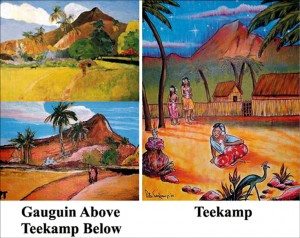 Paul Gauguin’s Death in the Marquesas Islands
Paul Gauguin’s Death in the Marquesas Islands
In 1901, debilitated and in conflict with the French authorities in Tahiti, Paul moved to the Marquesas Islands. He died at the age of 55, on May 8. 1903, and was buried in the Calvary Cemetery.
In his last years, Paul wrote, “For the majority, I shall always remain an enigma, I realize people will understand me less and less … No matter what happens, I assure you that I shall achieve things of the first order. I can feel it and we shall see.”
Paul’s prophecy was accurate. In 1906, three years after his death, his works were exhibited at Salon d’Automne, where his fame and popularity began.
Peter Teekamp as the Reincarnation of Paul Gauguin
Peter Teekamp was born in Holland, in the Netherlands, in 1950, 47 years after the death of Paul Gauguin. Peter’s father was Catholic, while his mother was Jewish.
Peter’s parents had marital problems and separated when Peter was four years of age. He was placed in a Catholic orphanage, where he became an altar boy and sang in the church choir. At the age of nine, Peter’s mother remarried and Peter went to live with his Jewish mother and new stepfather.
A Past Life Name, Gauguin, in Peter Teekamp’s Head: “Go-Gone, Go-Gone”
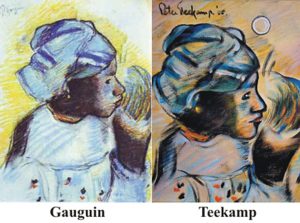
As noted, when he was ten years old, two syllables kept popping into Peter’s mind, “Go-Gone, Go-Gone.” Little Peter did not associate any particular meaning to these words, but he reveled in them. When he would play, Peter would shout, “Go-Gone, Go Gone,” as a cheer.
It wasn’t until he was fifteen that he started to wonder what “Go-Gone” meant. He asked his school teachers, “What does Go-Gone mean?” His teachers, thinking that he was inquiring about a Dutch word, told him that there was no such word in the Dutch language.
It is proposed that Peter was actually remembering his name from a past lifetime, that “Go-Gone” was a phonetic pronunciation of Gauguin. This type of remembrance was also observed in the reincarnation case of US Diplomat Wayne Peterson. As a small boy, Wayne wouldn’t respond to his name when his parent’s called him. In frustration, they asked, “So what do you want to be called?”
Wayne declared, “My name is Francesco Foscari,” though he had no idea why he wanted to be called that particular name. It took Wayne several decades to understand his name indeed was Francesco Foscari in a past lifetime. To learn more, go to the: Reincarnation Case of Francesco Foscari | Wayne Peterson
Innate Past Life Talent & Unconscious Replication of Gauguin’s Sketches through Reincarnation
 As a teenager, Peter began to draw. As noted above, a remarkable observation is that Peter’s early drawings replicated sketches that Gauguin had done almost a hundred years before, though Peter had no knowledge of these Gauguin sketches when he drew them.
As a teenager, Peter began to draw. As noted above, a remarkable observation is that Peter’s early drawings replicated sketches that Gauguin had done almost a hundred years before, though Peter had no knowledge of these Gauguin sketches when he drew them.
In fact, Peter Teekamp was not exposed to the Gauguin sketches until 2003, when Peter was 53 years old. As such, Peter was actually retrieving memories of his artwork from a past lifetime, the lifetime of Paul Gauguin.
What is interesting is that Peter replicated Gauguin’s artwork unconsciously at a much younger age than when Gauguin produced these sketches. As such, this phenomenon demonstrates that in each lifetime, we do indeed build upon accomplishments of prior incarnations.
Peter Teekamp Starts in Business, like Paul Gauguin
Peter attained a degree in business and like Gauguin, entered the business world as a career. Peter has worked as a manager of various retail operations over the years. Also like Gauguin, Peter became a world traveler, visiting places such as India, Israel, Portugal and Egypt, living in these locations for periods of time, paying his way by painting murals.
Paul Gauguin & St. Cloud in Minnesota and France
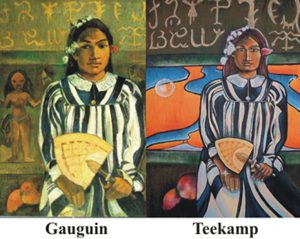
Eventually, Peter immigrated to the United States. In 1972, Peter settled in, of all places, St. Cloud, Minnesota, where he started to paint in a serious way at the age of 22. This is reminiscent of Gauguin moving back to France from Copenhagen, to become an artist full-time. Recall that one of Gauguin’s early paintings, upon his return to France, was “Paysage a Saint-Cloud,” which means “nature” or the landscape of Saint Cloud. It turns out that St. Cloud, Minnesota was even named after the city of St. Cloud, France.
What is the connection between St. Cloud, France and St. Cloud, Minnesota? I believe that what happens is that an individual can subconsciously recognize that a place has symbolic meaning from a lifetime gone by. Though Peter didn’t consciously know that St. Cloud had symbolic meaning for him from the Gauguin lifetime, I believe there was a subconscious recognition and attraction that derived from his soul, which influenced Peter’s decision to live in St. Cloud.
Peter is told about a Past Lifetime in France
In Minnesota, Peter married a woman named Angela and the couple had two children. Peter continued to manage retail stores and in addition, he pursued his career as a painter. He participated in art fairs, where he would sell his art.
Several times at these fairs, people came up to him spontaneously and told him about his past lives. One person told Paul that he had previously lived in France, another told him his name was Paul in a past incarnation. Peter didn’t know what to make of these comments, though he was open to reincarnation.
Peter has related to me that when he was 19 years old, he read Siddhartha, by Herman Hesse. At that time, Peter came to the conclusion that reincarnation is the only spiritual philosophy that embodies “justice and fairness,” that provides “an equal chance for everyone.”
Still, in the early 1970s, Peter did not have any idea of who he might have been in a past lifetime and the comments made by sidewalk psychics regarding a past lifetime of in France, in which his name was Paul, simply amused him and meant nothing more.
Angela has a Religious Transformation and Tells Peter he is Paul Gauguin, Reincarnated
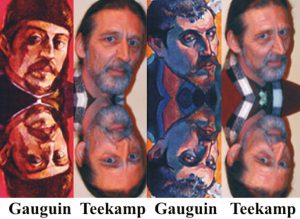
Things changed in 1979, when Peter was 29 years old. His wife, Angela, started to undergo a drastic change in personality, in which she became deeply religious. Though Peter initially honored her need to be more spiritual, he became worried that her new devotional lifestyle was becoming excessive.
One day, Peter walked into a room in their home and found his wife praying among lit candles. Angela rose and handed a book to Peter which fell open to a portrait of Paul Gauguin, surrounded by red hues. Angela told Peter, with deep conviction, “You are the reincarnation of Paul Gauguin,” an assertion she repeated to him thereafter.
Peter Realizes he looks like Paul and Hides Faces in Paintings, as did Gauguin
Angela’s insistence that he was Gauguin reincarnated made Peter reflect on the words, “Go-Gone, Go-Gone,” which echoed in his mind throughout his childhood. Peter also observed that his facial features were similar to Gauguin’s.
Later, he found that Gauguin liked to place faces in the background of his paintings, sometimes overtly, sometimes hidden, a practice that Peter had also spontaneously developed. As an example, in the Arizona mountain landscape provided below, click on the image to enlarge and note the face lying horizontally in the foreground that is looking up.
A video which reveals how Gauguin hit faces in his paintings can be viewed at the Hidden Faces of Paul Gauguin. Another video which demonstrates hidden faces in Peter’s work is entitled Gone Fishing.
Despite these parallels in the lives of Peter and Paul, it was still too bizarre for Peter to conceive that he could be the reincarnation of Gauguin.
Peter Creates Native Art, as did Paul Gauguin
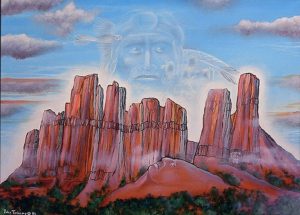 Peter and Angela grew apart over the years and despite efforts to preserve their marriage, the couple eventually separated. Peter relocated to Apache Junction, Arizona, where he opened an art gallery. Peter was attracted to the Native American culture of the Southwest, much like Gauguin was attracted to Tahitian life. Peter’s paintings during this period featured Native American themes.
Peter and Angela grew apart over the years and despite efforts to preserve their marriage, the couple eventually separated. Peter relocated to Apache Junction, Arizona, where he opened an art gallery. Peter was attracted to the Native American culture of the Southwest, much like Gauguin was attracted to Tahitian life. Peter’s paintings during this period featured Native American themes.
Peter Teekamp’s Past Life Regression
Soon after moving to Apache Junction, Peter met a woman who did past life regressions and Peter decided to give it a try. Peter had this regression in 1980, when he was 30. In the regression, he accessed memories from a lifetime in which he was indeed a painter.
Peter saw cobblestone streets in a city, perhaps Paris. He saw himself climbing up a dark stairwell to a studio that was dark and filthy; it appeared that the room had not been cleaned in years. Peter observed dirty, neglected paint brushes and he experienced a terrible feeling of depression, such as he had never experienced before. He felt loneliness, rejection and a feeling that he was misunderstood.
Whether in his past life regression he tapped into the lifetime of Gauguin, Peter is not sure. But the regression experience was powerful and it made him study Gauguin ever more earnestly. What he found, though, he did not like.
Peter Teekamp Refines Paul Gauguin’s Style of Painting
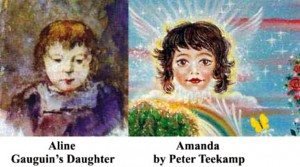 First of all, Peter did not like Gauguin’s style of painting, which he found “cartoonish, primitive and unfinished.” As mentioned, in this lifetime, Peter has developed a style that is more realistic. Indeed, in the Gauguin inspired art that Peter has created since 1995, the colors and feel are the same as Gauguin’s, but Peter’s renditions have more definition.
First of all, Peter did not like Gauguin’s style of painting, which he found “cartoonish, primitive and unfinished.” As mentioned, in this lifetime, Peter has developed a style that is more realistic. Indeed, in the Gauguin inspired art that Peter has created since 1995, the colors and feel are the same as Gauguin’s, but Peter’s renditions have more definition.
Paintings that demonstrate Peter’s progression of style include Gauguin’s portrait of his daughter, Aline, and Peter’s portrait of Amanda, a girl who died in childbirth. Amanda’s mother wanted a portrait of her unborn daughter and asked Peter to create an image of Amanda, who Peter had obviously never seen. As such, Amanda’s portrait is really an artist’s depiction, since she perished as a newborn.
It is interesting to note the similarities in appearance between Aline, Gauguin’s daughter, and Amanda. The painting of Amanda, though similar in appearance, is much more realistic with many detailed objects placed in the background, reflecting the style that Peter developed in contemporary times.
Peter feels Shame regarding Paul
In addition to the fact that Peter didn’t really admire Gauguin’s art, there were other things that chagrined Peter. For example, Peter didn’t like how some perceived that Gauguin had abandoned his wife and children to pursue a career in art. Lastly, Gauguin died of a venereal disease, which Peter did not find admirable. In short, Peter didn’t like this guy, Gauguin.
A Burly Chiropractor declares that Peter is the Reincarnation of Paul Gauguin
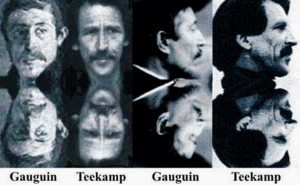 Eight years went by before the issue of reincarnation was raised once again. In Apache Junction, Arizona, in 1988 when Peter was 38 years old, he was befriended by a chiropractor who was a large, burly man in his mid-fifties. Over a period of two months, this chiropractor took Peter out to lunch or dinner two or three times a week.
Eight years went by before the issue of reincarnation was raised once again. In Apache Junction, Arizona, in 1988 when Peter was 38 years old, he was befriended by a chiropractor who was a large, burly man in his mid-fifties. Over a period of two months, this chiropractor took Peter out to lunch or dinner two or three times a week.
Though grateful for the man’s kindness, Peter began to wonder what the motive was for the man’s generosity. Peter is heterosexual, so he did not want the chiropractor to get any romantic hopes up. Peter decided to confront the issue at one of their meetings.
After Peter questioned the man regarding the reasons for his generosity, the chiropractor’s face grew red and he stood up, grabbing Peter by his shirt. The man drew Peter’s face to within five inches of his own and declared, “You are the reincarnation of Paul Gauguin.”
Peter was shocked, as he had not breathed a word to the chiropractor about Gauguin; the chiropractor simply had no way to know of Peter’s past experiences regarding Gauguin! The chiropractor then let go of Peter and left. Peter never saw him again. Now Peter had been told by two people, his former wife, Angela, and the chiropractor, who was nearly a stranger, that he is the reincarnation of Gauguin. The trouble was that Peter still did not want to be Gauguin.
Paul Gauguin’s Suicide Attempt Repeated at Superstition Mountain
 Watershed events occurred a year later in 1989, when Peter was 39. The landlord of Peter’s art gallery in Arizona unexpectedly walked in and told Peter that he was being evicted. The landlord related that Peter had signed a lease that had a clause in it that allowed him to evict Peter without notice and the landlord was evicting him immediately, as he received a better offer. So Peter’s business was about to be shut down.
Watershed events occurred a year later in 1989, when Peter was 39. The landlord of Peter’s art gallery in Arizona unexpectedly walked in and told Peter that he was being evicted. The landlord related that Peter had signed a lease that had a clause in it that allowed him to evict Peter without notice and the landlord was evicting him immediately, as he received a better offer. So Peter’s business was about to be shut down.
That same week, the woman he had been dating left him and Peter was involved in a major auto accident in which his car was totaled. Suddenly, Peter felt that he had lost everything that he had in the world and he became acutely suicidal.
Peter decided to kill himself in the desert. He bought a pistol and a bottle of whisky and headed out for the barren mountains. Fortunately, Peter is not a drinker and though he fired some shots into the desert air, Peter passed out from the alcohol before he could kill himself.
Recall that Gauguin also tried to commit suicide. Why would this type of pattern be repeated? In my observation, we have the same energies, the same approach to life, from one incarnation to another. As such, we also have the tendency to get into the same types of problems and conflicts; we also react to challenges in the same way.
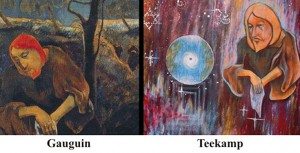 Gauguin and Teekamp both lived stable lives when they were engaged in traditional business and enjoyed financial stability, but they both gave up security to pursue the dream of being an artist. Both, in response to loss and financial crises became acutely depressed and suicidal, though both were unsuccessful in their attempts.
Gauguin and Teekamp both lived stable lives when they were engaged in traditional business and enjoyed financial stability, but they both gave up security to pursue the dream of being an artist. Both, in response to loss and financial crises became acutely depressed and suicidal, though both were unsuccessful in their attempts.
Reincarnation & Replication of Behavior from One Incarnation to Another
We all have a modus operandi that characterizes us. We have a set of behaviors that are consistent from one lifetime to another, some positive and some that are maladaptive. Maladaptive responses get us into trouble, though hopefully over a lifetime, we modify these traits to our advantage.
A great promise of understanding reincarnation is that once we know about past lifetimes and we are able to study our personality patterns from before, we can grow more consciously and effectively in our current incarnation.
After his Suicide Attempt, Peter Moves to California and Reconciles with his proposed Past Life as Paul Gauguin
When Peter woke up the following morning on the desert floor, he was hung over and had a major headache. Peter resolved that he needed to make a new start and decided that he should move to California. Peter also reflected that he had been in denial regarding the Gauguin lifetime and that even if he didn’t want to be the reincarnation of Gauguin, he would examine the possible past life connection with greater openness.
When Peter got back to Apache Junction, he called his former employer, an owner of a retail chain, and was pleased to hear that his old boss not only had a job for him in Atascadero, California, but that this employer was going to send a truck to pick him up. Peter reflects that since he decided to look at the Gauguin lifetime more seriously, things have seemed to go more smoothly and effortlessly for him; Peter states that life “flowered” for him.
Paul and Mette Gauguin, Reunited through Reincarnation
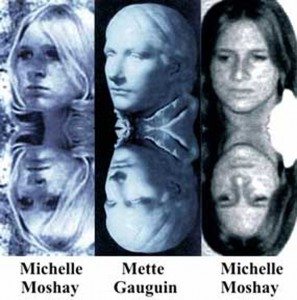 Peter did well managing the retail store in Atascadero and was promoted to managing an entire shopping center in Hollister, California. There, in 1991 when he was 41, Peter met Michelle Moshay, who worked for a local newspaper selling advertising space. Peter, representing the store and shopping center, became Michelle’s customer, placing ads in the paper she worked for.
Peter did well managing the retail store in Atascadero and was promoted to managing an entire shopping center in Hollister, California. There, in 1991 when he was 41, Peter met Michelle Moshay, who worked for a local newspaper selling advertising space. Peter, representing the store and shopping center, became Michelle’s customer, placing ads in the paper she worked for.
In 1997, at the age of 47, Peter decided to become a newspaper layout artist himself, in an attempt to better integrate his vocation and avocation. In this capacity, Michelle became his mentor in regards to the newspaper trade. It was at this time that Peter and Michelle felt a deep resonance towards each other and they became close friends.
Peter began sharing details of his life, including the stories regarding Gauguin. Michelle was not a believer in reincarnation at the time, but she was open. Michelle then shared with Peter a series of synchronistic events of her own involving Gauguin. Michelle, by the way, was 41 years old when she met Peter.
Michelle’s Past Life Connection to Paul Gauguin
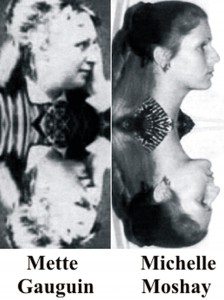 In 1978 when she was 22 years old, Michelle’s father offered to fund a trip to wherever she wanted to go in the world. Michelle chose to go to Tahiti and when she was there, she visited the Gauguin Museum.
In 1978 when she was 22 years old, Michelle’s father offered to fund a trip to wherever she wanted to go in the world. Michelle chose to go to Tahiti and when she was there, she visited the Gauguin Museum.
The next year, Michelle went to Paris. She went sightseeing on the Seine on a barge cruiser named the Wandering Wasp (Les Guepes Buissonniere). Interestingly, Gauguin edited a publication in Tahiti entitled, The Wasp. When in Paris, Michelle was 23 years old, the same age Mette was when she met and married Paul Gauguin in France.
Michelle becomes Peter’s Reincarnation Research Partner
Peter had been working on a journal, which included his contemplations on Gauguin, and Michelle offered to help Peter with editing of the journal. As such, in 1997, they became partners in researching Gauguin and writing an account of Peter’s story.
Shortly thereafter, they opened one of the first biographical books Michelle bought on Gauguin. Peter looked at the image on the page and he exclaimed to Michelle, “Look, it’s you!” Peter was looking at a picture of Gauguin’s wife, Mette, and the resemblance to Michelle was undeniable.
Peter and Michelle continued to quietly ponder the possibility that they were the reincarnations of Paul and Mette Gauguin and the years went by. In 1999, Peter departed for what would become a four year tour of the world, painting murals as he traveled. Peter kept in touch with Michelle, corresponding with her, much like Paul had corresponded with Mette when he was in Tahiti.
Michelle Discovers the Gaugain-Teekamp Reincarnation Parallel Sketches
Michelle, in the interim, moved to Washington state to be near her family and her childhood sweetheart. While Peter was traveling, it was Michelle who took it upon herself to research Gauguin extensively and it was she who found Gauguin’s pencil sketches featured at the top of this page. It was Michelle who first realized that Peter, in his youth, had unconsciously replicated Gauguin’s drawings.
When Peter returned to the US in 2003, Michelle’s mother found a cottage apartment for him in nearby Bremerton, Washington and Peter moved in. It was then that Michelle showed him the sketch comparisons, which Peter found amazing.
In particular, Peter was impressed with their corresponding sketches of Jesus from above the cross. For an artist, Peter saw this as a very unique and unusual point of perspective. The comparison of Peter’s and Gauguin’s drawings added to the growing list of experiences that made Peter start believing that he might indeed be the reincarnation of Paul Gauguin.
Michelle has created a video regarding the parallel sketches: Reincarnation and the Transformation of Society
To view a video of Peter and Michelle together, of Paul and Mette reunited, go to My Friend Muralist Peter Teekamp in Haifa Israel.
Peter’s Discovery of a Paul Gauguin Charcoal Sketch
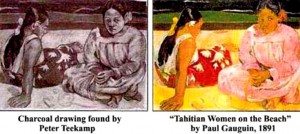 One day, as he was walking through Bremerton, a wall mural caught his eye. A restaurant was situated next to the mural and Peter went in for a cup of coffee. As he looked around the interior, Peter spotted what appeared to be a Gauguin charcoal of two women on a beach. Peter assumed this was a print, a reproduction, of the original Gauguin sketch.
One day, as he was walking through Bremerton, a wall mural caught his eye. A restaurant was situated next to the mural and Peter went in for a cup of coffee. As he looked around the interior, Peter spotted what appeared to be a Gauguin charcoal of two women on a beach. Peter assumed this was a print, a reproduction, of the original Gauguin sketch.
Peter asked the proprietor where he obtained the Gauguin print. The proprietor related that the sketch originally was in the possession of his great-grandmother in Guam, who was given the sketch as a gift. He explained that the native people of Guam were displaced by the Japanese during World War II. His great-grandmother and her family hid in caves until the occupation ended. She took the sketch with her during their period of hiding.
After the war, his great-grandmother stored the sketch in her attic for 33 years until 1978, when she gave it to her daughter, the proprietor’s mother. The proprietor received it from his mother. When he immigrated to the United States in 1999, he brought the sketch with him and later hung it on the wall of his restaurant.
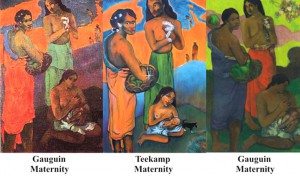 The proprietor told Peter that when he removed the sketch from its protective container, he found charcoal on his hands. This made Peter realize that the artwork was not a copy at all, but an original charcoal sketch. If it was indeed an original Gauguin, which Peter believes it is, then the sketch would be worth millions.
The proprietor told Peter that when he removed the sketch from its protective container, he found charcoal on his hands. This made Peter realize that the artwork was not a copy at all, but an original charcoal sketch. If it was indeed an original Gauguin, which Peter believes it is, then the sketch would be worth millions.
The proprietor then shared that he was in financial straits and needed money to keep his business afloat. Rather than waiting for the sketch to be authenticated, the proprietor said he would sell the sketch for $5000 to the first person who would pay him that amount. Peter agreed to purchase the sketch and gave the proprietor $5000.
If the sketch is indeed authenticated, Peter Teekamp came into possession of what appears to be an original Gauguin work of art. Further, it is interesting that Peter found the Gauguin sketch in 2003, which is the 100 year anniversary of Gauguin’s death.
Paul Gauguin Charcoal Sketch is for Sale
Peter has done extensive research to help validate that it is an authentic Gauguin sketch. Parties interested in purchasing this charcoal, please contact Walter Semkiw, MD at: walter@reincarnationresearch.net
Reincarnation & Synchronistic Events: A Form of Spiritual Communication
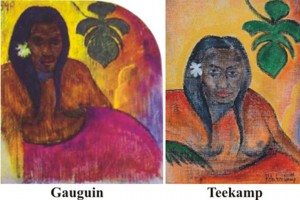 Synchronicities and anniversary phenomena are ways that the spiritual world, including our own souls, can communicate with us. Recall that Michelle had the option of traveling anywhere in the world and that she elected to visit Tahiti, where she visited the Gauguin Museum. She then visited Paris at the same age that Mette met Paul Gauguin.
Synchronicities and anniversary phenomena are ways that the spiritual world, including our own souls, can communicate with us. Recall that Michelle had the option of traveling anywhere in the world and that she elected to visit Tahiti, where she visited the Gauguin Museum. She then visited Paris at the same age that Mette met Paul Gauguin.
Such synchronistic events, I propose, are not always accidental, rather, they are orchestrated by our spiritual guides and our own souls, though telepathic messages which are experienced as intuitions and desires.
In the same way, we can see Peter’s finding of what appears to be an original Gauguin charcoal sketch on the 100 year anniversary of Gauguin’s death as a symbolic event. It can be seen as an event orchestrated by beings in the spiritual world, who led him through intuition to find the sketch in the Bremerton coffee shop. This event had the purpose of reinforcing to Peter that he is the reincarnation of Gauguin.
A very similar event occurred in the reincarnation case of Carroll Beckwith | Robert Snow, as Captain Snow was intuitively led to the painting of the hunchback woman, which allowed him to solve his reincarnation case. Other examples of such guidance in reincarnation cases are compiled in the section: Spirit Being Involvement in Reincarnation Cases.
Soul Contracts in Reincarnation Cases
In the same light that Peter was led to the charcoal sketch by the intervention of spirit beings, Peter’s rendezvous with Michelle in California can be seen as not accidental, but predetermined. We make agreements or contracts before we are born to meet up with people we have known in prior lives.
Drawing on Accomplishments of Past Lives
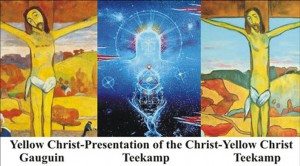 The reincarnation case of Paul Gauguin | Peter Teekamp, if accepted, it is a historic case, as it demonstrates that we do indeed draw upon accomplishments earned in prior incarnations, as demonstrated in the parallel Gauguin-Teekamp sketches and Peter’s effortless replication of artwork reminiscent of Gauguin.
The reincarnation case of Paul Gauguin | Peter Teekamp, if accepted, it is a historic case, as it demonstrates that we do indeed draw upon accomplishments earned in prior incarnations, as demonstrated in the parallel Gauguin-Teekamp sketches and Peter’s effortless replication of artwork reminiscent of Gauguin.
It is also interesting to observe how themes in the art of Gauguin and Teekamp show similarities, even though Peter developed a more detailed and surrealistic style of art. This is demonstrated in the image comparison provided to the right. In this comparison, Paul Gauguin’s “Yellow Christ” is on the left side, Peter Teekamp’s “Presentation of the Christ” is in the center and Peter Teekamp’s version of the “Yellow Christ” is on the right. The central theme across two lifetimes is Jesus Christ, though the style of painting has evolved.
Physical Resemblance in Reincarnation Cases: Peter Teekamp’s facial features are consistent with those of Paul Gauguin.
Past Life Talent: Peter demonstrated a talent for art as a young boy and in his formative years, he unconsciously replicated the artistic development of Paul Gauguin, as demonstrated in the parallel sketches. Though Peter did these sketches from the ages of 16 to 26, he did not see the Gauguin sketches until 2003, when Peter was 53 years old. As noted, Peter did the sketches at an earlier age than Gauguin, as Gauguin did the sketches in his 40’s. This shows that we do advance from lifetime to lifetime, building upon accomplishments of prior incarnations.
Planning Lifetimes and Relationships Renewed through Reincarnation: Peter was reunited with Michelle Moshay, who appears to be the reincarnation of Mette Gauguin, the wife of Paul Gauguin. Though they are not romantic in contemporary times, Peter and Michelle have become very close friends and partners in researching their reincarnation cases.
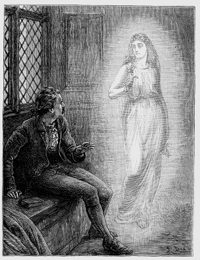 Spirit Being Involvement and Spiritual Communication: It is likely that spirit beings were involved in creating circumstances that helped Peter understand that he is the reincarnation of Paul Gauguin. These include Peter’s former wife, Angela, and the burly chiropractor in Arizona, telling Peter that he is the reincarnation of Gauguin. Spirit beings most likely telepathically inserted these thoughts into the Angela’s and the chiropractor’s minds. Recall that these events occurred totally independently and that Peter never told the chiropractor anything about his possible past life connection with Gauguin.
Spirit Being Involvement and Spiritual Communication: It is likely that spirit beings were involved in creating circumstances that helped Peter understand that he is the reincarnation of Paul Gauguin. These include Peter’s former wife, Angela, and the burly chiropractor in Arizona, telling Peter that he is the reincarnation of Gauguin. Spirit beings most likely telepathically inserted these thoughts into the Angela’s and the chiropractor’s minds. Recall that these events occurred totally independently and that Peter never told the chiropractor anything about his possible past life connection with Gauguin.
Similarly, Peter was likely led by spirit beings or his own soul to the coffee-house in Bremerton, Washington, where he found the Gauguin charcoal, which is likely an original sketch done by Paul Gauguin. Similar guidance was specifically observed in the reincarnation case of Carroll Beckwith | Robert Snow, as Captain Snow was led in New Orleans to the painting of the hunchback woman, which allowed him to solve his reincarnation case.
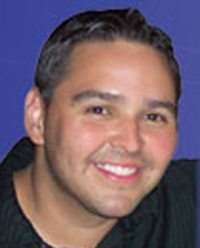 Felix Lee Lerma is a compassionate and genuine Psychic Medium living in San Francisco. In March of 2002, in New York City, an Internationally Acclaimed Psychic Medium confirmed what Felix always knew: That he is psychic and has the ability to communicate with those who have passed.
Felix Lee Lerma is a compassionate and genuine Psychic Medium living in San Francisco. In March of 2002, in New York City, an Internationally Acclaimed Psychic Medium confirmed what Felix always knew: That he is psychic and has the ability to communicate with those who have passed.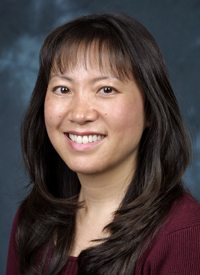
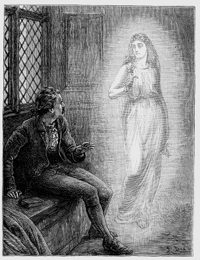
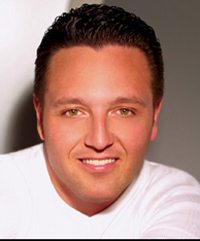
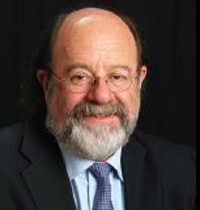 Gary E. Schwartz, PhD, is a professor at the University of Arizona and the Director of its Laboratory for Advances in Consciousness and Health. Dr. Schwartz received his PhD in psychology from Harvard University and was a professor of psychiatry and psychology at Yale University before joining the University of Arizona.
Gary E. Schwartz, PhD, is a professor at the University of Arizona and the Director of its Laboratory for Advances in Consciousness and Health. Dr. Schwartz received his PhD in psychology from Harvard University and was a professor of psychiatry and psychology at Yale University before joining the University of Arizona. The five mediums who participated in this experiment were
The five mediums who participated in this experiment were 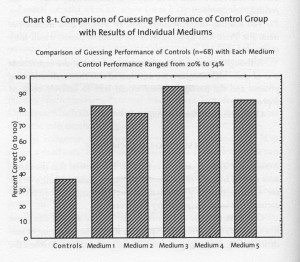
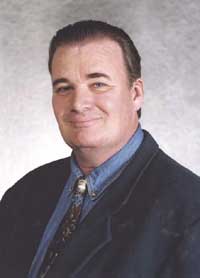 A well-known trance medium who works in this way is
A well-known trance medium who works in this way is 